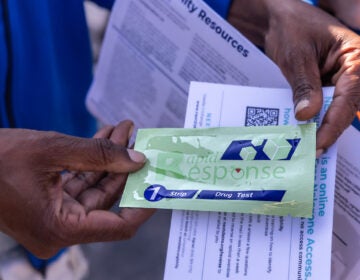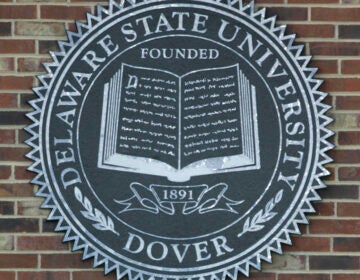Research at Delaware State shoots for the stars
When it comes to research in Delaware, the University of Delaware gets the lion’s share of attention, but Delaware State University in Dover is working to build its reputation for quality research, and forget going global. DSU researchers are shooting for the stars.
DSU goes to Mars
When an Atlas V rocket blasted off from Cape Canaveral in Florida just after Thanksgiving last year, two researchers from Delaware State University were on hand. “It was astounding. It’s kind of like a once in a lifetime thing,” says DSU Ph.D candidate Alissa Mezzacappa. The rocket carrying NASA’s Curiosity Rover is now on its way to Mars, with an expected arrival in August. Once it lands, the Rover will explore the make-up of the Red Planet and try to determine whether life ever existed there.
To figure out what is on the surface, Curiosity will fire a laser at the Martian surface and use a special camera located on the Rover to send data back to researchers on Earth, including those at DSU. To prepare for that flood of information, Mezzacappa has designed a chamber to mimic conditions on Mars. “We’re basically doing our last minute preps for seeing that data, so we’re doing studies that are very specific to Mars, that will help us interpret the data that we see.”
All that work is going on in DSU’s optics lab, part of a program founded by Dr. Noureddine Melikechi. The school’s optics program got its start in the 1990’s as part of an effort by the state under then-Governor Tom Carper to encourage technology research. “The optics center has grown from that seed that Governor Carper planted to the point today where we do space optics,” says Melikechi, who is also DSU’s VP of Research.
But the optics research at DSU has applications that are much closer to home too. “We develop optical techniques for health, and preventative health in particular.” The same spectroscopy techniques used to study the surface of Mars can be used to detect early signs of cancer. “We’re looking for something on the Mars planet, which is a complex environment. We’re also looking for some specific things in blood, which is also a very complex environment.”
Beyond Optics
While optics may be DSU’s most high profile research endeavor, it’s far from the only one. Dr. Eric Kmiec heads up DSU’s Chemistry Department and also brought his biotech company OrphageniX to the Dover campus. The company was founded at the University of Delaware, but has now found a home at DSU. Kmiec’s team is exploring ways to stop sickle cell anemia using a gene editing technology. He says doing research at a Historically Black College on a disease for which African Americans are at a high risk is just coincidence. “I think it also enables students to become a bit more engaged in a bit more passion because it does affect African Americans, and in my view, that population has been underserved by the government, the state and by the therapies that have gone forward.”
Kmiec is now working to set up a clinical consortium with the University of Pennsylvania, Christiana Hospital and Children’s Hospital in Philadelphia to test the technology. Researchers should know within the next three years whether the technology works on sickle cell anemia or not. He says, “The company is now looking to raise money with investment from outside, but to also provide a foundation and a source for a bio-tech company on this campus.”
Elsewhere on campus, dissected mice are being used to learn more about a deadly disease that affects some very young children in Delaware called Spinal Muscular Atrophy. “It’s not super common, but it’s about one out of 6,000 live births,” says biology professor Dr. Melissa Harrington. “In Delaware, that’s about a couple kids every year that are born with Spinal Muscular Atrophy.” She says using students in research helps them connect the classroom to real world problems. “It’s a wonderful thing for their education too because it makes what they learn in class real, and helps connect it to things that matter. That really is a big motivator.”
Building research
There has been a concerted effort at DSU to improve the school’s research capabilities in recent years. Harrington says she’s seen big changes in the way DSU’s administration views research. “The changes I have seen in this institution is just amazing.” She says when she first came to DSU from Georgia, she had to convince school leaders to bring her lab equipment along with her or else she would lose her grant funding for research. But the increased focus on supporting research has made a big difference. “For the size of our institution, there really is some very good support. I have a great lab, and release time to do the research. We’ve had some success getting grants.”
Kmiec says a focus on research helps in other areas on campus. “More research activity in this school will bring more employment, more students, and will certainly raise the bar scientifically.” He also credits DSU’s administration with deciding to make the change to improve the school’s research endeavors. “It’s really time. DSU is rising and we’re very excited to be a part of it, and we hope that we can engage the community.”
Melikechi says the ultimate goal is to make DSU a Research 1 university, like the University of Delaware. It’s a process that takes time, but at least now DSU is on its way. “I think it has taken a quantum leap in the last few years, the research here at Delaware State University. And it’s on the way up, and we hope we can contribute to the economic development of this region of Delaware and to this region of the nation.”
And with their work on the Mars mission, DSU researchers may be able to contribute to a greater understanding of the universe. Melikechi says, “I personally believe that this mission, this unmanned mission to Mars is going to inspire thousands and thousands and possibly millions, not just at Del. State, but around the world.”
WHYY is your source for fact-based, in-depth journalism and information. As a nonprofit organization, we rely on financial support from readers like you. Please give today.




